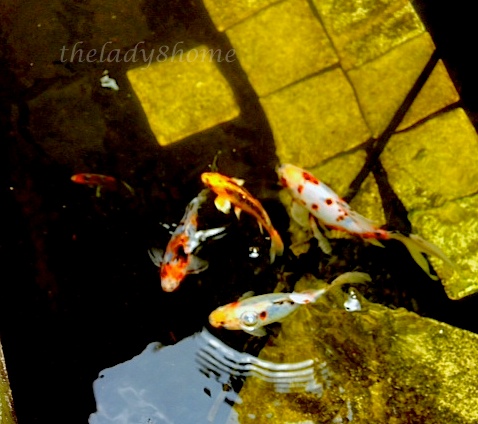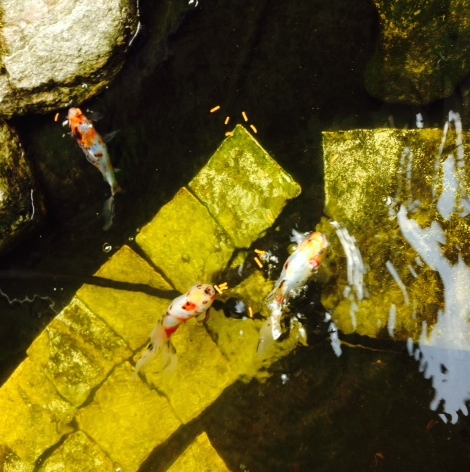 The motor came to a sluggish stop, fourth time that day, as it tried its best to suck the mucky green water and spit clean water out , a futile attempt. The decomposing leaves from the fall broken down by the harsh winter followed by pollen filled spring turned the clean clear pond in to a green cesspool. The heat of the summer means the fish eat and release loads of ammonia into the water. Not that the fish minded much. Their streamlined bodies cut through water often enough, though they concentrated their circles around the aerator, not realizing that algae heavy ammonia filled mucky water was short on oxygen and heavy on their gill. Or maybe they did understand?
The motor came to a sluggish stop, fourth time that day, as it tried its best to suck the mucky green water and spit clean water out , a futile attempt. The decomposing leaves from the fall broken down by the harsh winter followed by pollen filled spring turned the clean clear pond in to a green cesspool. The heat of the summer means the fish eat and release loads of ammonia into the water. Not that the fish minded much. Their streamlined bodies cut through water often enough, though they concentrated their circles around the aerator, not realizing that algae heavy ammonia filled mucky water was short on oxygen and heavy on their gill. Or maybe they did understand?
The clarifiers and phosphate killers came out of the cabinet and in they went into the water. The fish decided they had had enough and clung to the bottom of the pond to show their intense displeasure.
The chemicals lost their fight. The water turned into a murkier green brown yuck. We put in the pool cover pump and emptied the pond. Using a small bowl, we fished the fish out one by one (flailing and flapping buggers were really hard to catch) and transferred them to a makeshift tank ( a toy box borrowed from my younger one). Then we washed the mucky bottom, wiped it clean. We also patched two leaks in the rubber and then filled it back up. Let it sit for 24 hours and then let the fish back in.
The fish think they are in a new place. I watched them exploring every nook and corner of the pond. The clean, crystal clear abundance of H2O has obviously put them in good spirits. We now have six of them. The three older koi, one gold-fish I added last summer and two toddler fish that spawned last year. I lost 9 out of 11 spawned, I never saw where those went. Decomposed maybe? The prettiest one got sucked into the aerating pump. We were scared for the last two, but looks like they are made of sterner stuff, and made it through the winter.
So how do you maintain a Koi Pond?
Pond Koi is a hardy fish and can withstand a lot of mauling that the pond goes through, especially in North America where temperature fluctuations are in the extreme. They can live through mounds of snow and very little water by hibernating, but they do need clear water, and lots of oxygen when it’s summer and warm.
Tips to a healthy Koi Pond:
a) Make sure the pond is not over crowded. One 6-8″ Koi fish should have at least 150 gallons of water to itself. A 500 gallon pond should not have more than 4 such Koi fish, better if there are less. If you have larger pool, go ahead and add more, or wait for them to reproduce.
b) Pump out 20% of water every week. Fill up a tub or a bucket with tap water, add de-chlorinator, follow the instructions on the bottle and pour the water back into the pond.
c) Do not over feed the fish.
d) If you think the water is causing a problem, or that there is a leak, etc and you feel the need to save the fish, then do what I did. Fill a large tub – I used a 50 gallon plastic toy box from my son’s room – with clean water. Let the water sit for sometime, especially if it’s cold. The temperature of the water now will be close to what it is in the pond (this is to prevent shock from temperature difference that can be fatal to the fish. TIP: It’s always advisable to transfer from cold to warmer than the other way around). De-chlorinate the water (VERY IMP, else the fish can die of chlorine burns on their gills). Using a small bucket, scoop the fish out along with some water, and release the fish in the tub. If keeping the fish longer than 1 day, then put in a pump for aeration. I saved three 8″ Koi the winter two years ago with this method after my pond leaked and my goldfish died.
e) Invest in a de-icer if you live in a region that gets a lot of snow. A good pump and the de-icer will make sure your fish remains healthy and gets the much-needed oxygen during the time when everything freezes over.


7 comments for “The pond story – Easy Tips for maintaning a Koi Pond”